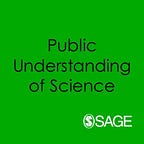The Many Voices of Modern Physics: Written Communication Practices of Key Discoveries
Review by Felicity Mellor
An understanding of audience is central to the practice of rhetoric. Harman and Gross cast their own audience wide, pitching their book at physicists, communication scholars and scholars of Science and Technology Studies.
Among “the many voices” promised in the title of this book, one is sadly suppressed. Alan Gross died before the book was completed, leaving his co-author Joe Harmon with the difficult job of re-drafting the manuscript without the input of his long-term collaborator. In an affectionate afterword to the book, Gross’s colleague Randy Allen Harris remembers Gross as a pioneer in the rhetoric of science and reflects on the long collaboration with Harmon.
As Harris tells it, it was this collaboration that encouraged Gross to move away from his initial interest in the role of rhetoric in the production of knowledge to a less radical interest in the mechanics of communication. Separating the pair’s collaboration into two tracks, Harris places this, their final book, on the Harmon track where they focused on specific communicative practices. The book is certainly specific, guiding the reader through an array of examples — often quoted at length — of the popular writing through which theoretical physicists have explained their ideas to non-specialist audiences.
An understanding of audience is central to the practice of rhetoric. Harman and Gross cast their own audience wide, pitching their book at physicists, communication scholars and scholars of Science and Technology Studies. It was ambitious to address such a mixed audience with a work that covers the highly technical and abstract concepts of 20th-century physics. The selection of texts is also cast widely — as well as classic popular physics books, there are extracts from interviews, journalism, patents, letters, memoir and even an aria from an opera. As the authors note, they use the term popularisation as a “catchall” to capture all forms of communication aimed at non-specialist audiences, an approach that highlights the many and varied non-technical contexts in which abstruse ideas in physics have found traction.
This is not, then, a book about physicists’ popular science writing as a genre. What it is, is an illustration of common rhetorical motifs found in non-specialist communication about physics. Chapters demonstrate the use of analogy and metaphor, thought experiments, visualisations and conjecture. Hedging, definition and semantic complexity are also mentioned.
Much of the book is taken up with the extracts themselves, and with the lengthy explanations that are needed to make sense of the physics being presented. In other words, much of the book is itself a popularisation, in which, of course, the authors must make their own rhetorical choices, such as the metaphor of a “subway map” to describe a circuit diagram. Among their choices is the decision not to reflect on this inherent metaphoricity of language, nor on how, or whether, physics differs from other fields of knowledge in its use of metaphor.
The book takes a broadly chronological approach, starting with Einstein’s theory of relativity and the public attention this attracted. The first extract comes not from a popularisation but from Einstein’s 1905 paper on special relativity. The contrast of this with subsequent popularisations of the theory, by Einstein himself and by other physicists, serves to illustrate the ways in which the physicists adapted their writing to their intended audience.
The following chapters move straight to the popularisations, covering developments in general relativity, quantum theory, particle physics, cosmology and condensed matter physics. The authors note that they do not intend the book as a history of ideas, but their chronological approach makes it difficult for an alternative analytical perspective to emerge. Only the final two chapters deviate from the chronology in favour of a more thematic approach, with Chapter 8 highlighting astronomers’ need to satisfy their patrons and Chapter 9 using the development of the atom bomb to examine the case of persuasion for policy purposes.
Ultimately, the book’s range — both in terms of its target audience and the texts it samples — is also its weakness. Readers may be disappointed if hoping for insights into the strategic choices physicists make in different rhetorical situations when they try to communicate ideas that have no contact with everyday experience. However, those wishing to revisit the history of 20th-century physics may be charmed by the chorus of voices found in these pages.
Felicity Mellor is Director of the Science Communication Unit at Imperial College London. She has a PhD in theoretical physics. Her research examines media representations of science, especially of physics, and her publications include The Silences of Science: Gaps and Pauses in the Communication of Science, co-edited with Stephen Webster (Routledge, 2017).
